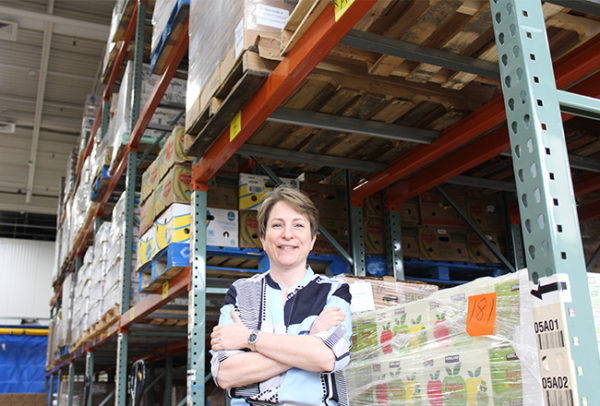
Leslie Gordon, the president and CEO of Feeding Westchester, met with the Business Journal for an hour-long talk at the nonprofit”™s Elmsford office to discuss its new name and future plans. But first, she told a story from her family history.
She grew up in New Castle and attended school in Ossining, but would visit her grandfather in Tarrytown every Sunday. Gordon recalled a story her mother liked to tell her from her own childhood, one in which Gordon”™s grandfather appeared to operate his own small food bank.
“His synagogue would pass names along confidentially to him of families in need,” she said. “And he”™d take my mom and say ”˜We”™re going out.”™ And in those days, there weren”™t food pantries or soup kitchens or places to gain access to a hot meal in a formal way.”
Instead, he”™d simply place the groceries on people”™s front steps, ring the doorbell and walk away.
“It”™s a story that has really stuck with me about the importance of not only giving back, but what really resonates is that it”™s important for all of us to play a role in feeding our residents in Westchester,” Gordon said.
Two generations later, Gordon”™s job puts her in charge of an organization that provided more than 8 million pounds of food to people in need last year. In March, that organization changed its name from Food Bank for Westchester, which it has carried since its founding 30 years ago, to Feeding Westchester.
What made you want to take over leadership of the then-Food Bank for Westchester?
“Quite frankly, who wouldn”™t leap at an opportunity to help your neighbors? I find it”™s a real honor, it”™s an honor to be able to make a difference with my neighbors.
It was a no-brainer. I don”™t know how many people get an opportunity to contribute to a place that they”™ve called home for so long.”
What does the name Feeding Westchester mean for the organization?
“The new branding really conveys in an enhanced way what we do. What I love is that ”˜feeding”™ is an active verb, it very literally tells you right away the business that we are in. It”™s very easy to get into a conversation about the work we do. People say Food Bank? And they had all kind of ideas about what that is. This helps us more rapidly engage in meaningful conversation.
We”™re at the heart of a network of 300 partners that help us move food to people who need it. It”™s food pantries, soup kitchens, shelters, senior centers, housing complexes, health clinics. You name it. There”™s an amazing array of organizations that we count on and they count on us, to connect people with resources.
The rebrand itself is the product of extensive research by a national marketing firm called Interbrand. We”™re leveraging that here with Feeding Westchester.”
Right, I imagine the process for changing a name is a lot more complex than it sounds.
It took us the better part of 10 months, working very quietly and strategically behind the scenes to launch the brand. We have a new website, which we”™re really proud of as a vehicle to spread awareness.
As for the name, feeding people is not just about food. Hunger is a very complex issue. Hunger is what you feel when you don”™t have enough to eat. But it”™s a symptom of a much deeper array of challenges that people bump against when you”™re struggling on limited incomes.
It”™s unemployment, underemployment, housing issues, illnesses. There are all kinds of reasons why people find themselves on a line at a food pantry or going to one of the distributions that we do. We”™re looking to tackle that and, in other words, shorten the line.”
How do you tackle that?
“We”™re also giving people food for today, but we also want to play a role in helping people to not have to access food as often, if at all. On the programming side of the business, we have a full-time staff person who roves throughout the county to screen people who we believe may be eligible for SNAP, formerly called Food Stamps. It”™s facilitating their application process, because unfortunately it”™s a little cumbersome. She works particularly with seniors and people who are disabled. It”™s actually a really dignified way of going through that process.
We provide nutrition education, free of charge. We have a registered dietician on staff and someone else who has a master”™s in nutrition. They provide a class called Just Say Yes to Fruits and Vegetables. It”™s a cool class, seriously. They make thinking about eating healthy feel really accessible, and just plain fun.
And it”™s very important because there”™s something that goes on in a lot of the communities where we serve people. It”™s the hunger-obesity paradox. There is a high rate of people who struggle with diet-related diseases. Obesity, hypertension, cardiovascular disease and diabetes.
People on low incomes have to make really tough choices at the supermarket. If you were to talk with one of our clients, they very likely will tell you that they avoid the perimeter of the grocery store: the dairy department, meat and poultry, the produce department. Places where your healthiest food tends to reside.
What”™s affordable in our food system for people on limited incomes is often food that has high rates of fat, sugar and salt.
And that”™s why nutrition education is important. We help people build their knowledge, confidence and skills to eat healthy and feed their families healthy food on a limited income.”
So how does Feeding Westchester grow under its new name?
We”™re in the middle of a five-year strategic plan. This is year two of that plan. Contextually, the need in the county is startling. There are nearly 17 million meals that are missing from people”™s plates on an annualized basis in this county. People who just don”™t have enough for lunch, breakfast, dinner.
Our commitment as an organization is to feeding at least half of what”™s needed every year, in terms of meals in the county by the 2021. Within that context, it”™s the feeding people for today, tomorrow and the future. The plan also focuses on some of our most vulnerable populations, so seniors and kids. There are 58,000 kids in this county who don”™t always know when their next meal is coming
The plan started at a little over 7 million pounds (food distributed per year). By the end of it, we”™ll be at about 10.5 million pounds distributed or more annually by 2021. That”™s the overall goal.”
Where does Feeding Westchester get the food it is then able to give? Is it mostly donated? Purchased?
“It”™s a combination of both. The fresh produce is the largest growing portion of our overall inventory. A lot of that comes from generous donors. What”™s really interesting about our business is that I tell people what we do is good for people and it”™s good for the planet.
We rescue good excess food that would otherwise go to waste and very literally end up in landfills, with partnerships with nearly 80 retailers in Westchester County, including Stop & Shop, Acme, ShopRite, Whole Foods, Trader Joe”™s, BJ”™s, Walmart, Target.
Maybe it”™s a new product that just didn”™t really fly well with consumers, but there”™s nothing wrong with it. Another is because it might be coming to its use-by, sell-by, use-before dates. That”™s part of the disastrous vocabulary of what we put on products here in the U.S.
Food goes to waste because we”™ve been acculturated, effectively, to these dates, which are there for in some cases artificial reasons. Sometimes it”™s that a manufacturer wants to make sure you”™ve got the peak of quality.
And so we capture a good excess product that would otherwise go to waste. Nearly 40 percent of the food produced in the United States ends up in a landfill.
All of that food could actually feed almost everybody who is hungry right here in the great United States of America. So when I say it”™s good for people and the planet, it”™s because food in landfills, when it doesn”™t get oxygen, is the largest creator of methane gas. That creates issues for the ozone layer and our ecosystem.
We”™ll rescue this year, gosh, nearly 3 million pounds, if not more, of good excess food that would very literally have gone into a landfill, and it”™s perfectly fit for human consumption. We like to think that we”™re playing a role in getting food to people and helping to sustain the planet at the same time.”
Westchester has a reputation as a very wealthy county. How does that affect what you are trying to do? Is it harder to get the word out there about this issue?
“Part of the brand transition is to help broaden the conversation about the need here in the county. Unfortunately, the perception is that this is a county that is very affluent, and yet 20 percent of our neighbors are struggling silently and don”™t always know where their next meal is coming from. That”™s one in five, or nearly one in three kids, in this county. It”™s significant. And it lives everywhere.
Your neighbors need your help in this county and together we can all help feed Westchester.”
Note: The interview was edited and condensed for clarity.




















